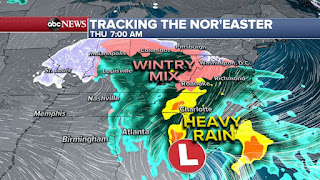The Mid-Atlantic Nor'Easter, and why the time AFTER can be so dangerous
February 21, 2019
Regular Homeowner Advice for those in the Mid-Atlantic by: EFynch.com
 | ||
| Winter Weather Reports often give homeowners a few days for preparation. Prep for what? We never know what were getting |
For outsiders (especially those from areas like Buffalo, NY)- a Nor'Easter is just another time to let us know how much snow you had growing up and to question why cities from D.C. to Philly shut down for a "measly 6'"!
However, if you are from the Mid-Atlantic area (like us here at EFynch), you know it is so much more.
 |
| Icy roads in the D.C. area can often happen in an instant bringing communities to gridlock. |
The fact remains, it's a frozen "something" that is unclassifiable. It coats streets in a way that appear to overpower the general chemistry of salt. But, the worst part, it melts every day and freezes every night. THAT, is where the issues arises.
Let's forget about traffic and 2 hour delays. This wreaks havoc on your homes, driveways, roofs, decks, , , everything. It can also be argued it is one of the most dangerous aspects of the storms.
Each day as water melts it penetrates in every crack and weak point. Then, at night it freezes, expands, and can cause slippery conditions and expand cracks that can hurt your back, and your wallet.
 |
| Homeowners need to watch for overnight lows and prepare for icing. |
After a storm like the one we just experienced, it is important to keep an eye on the weather and take the following precautions:
- Clear driveways, walkways, and decks as soon as the event ends. (some counties have laws requiring you to do so, see article)
- Try to keep foot traffic on these areas to a minimum until you have them cleared. Footprints compact snow/ ice, making it harder to clear.
- Apply your preferred ice melt solution early in the day in order to provide enough time to melt any ice/ snow AND evaporate during the day.
- Take note of LOW temperatures and be careful of re-icing. Re-Apply Ice Melt as needed.
- Make sure all drainage areas and sewers are clear of debris and snow.
- If you have an area that is typically shaded or tends to stay damp, consider shoveling snow away from this area semi-regularly during storms. This can prevent snow and ice from becoming dense and making it more stubborn.
- Make sure Gutters are clean, clear, and operations BEFORE storms hit. This helps snow melt and drain from your roof to prevent ice damming/ damage.
 |
| Ice damming can cause quick damage and after the storm, the exact source is often untraceable. |
Weather is unique in the Mid-Atlantic because we are just on the cusp, somewhere between winter wonderland the Carolina "Crisp Breeze". This, is actually where I think most of the problems come from. Be safe out there!
*Washington Beltway Traffic Congestion; repairs, issues, and fixing gridlock for D.C., Virginia, and Maryland homeowners.


